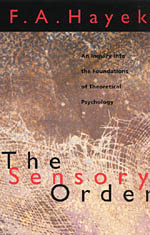
In an interesting new paper, my colleague Paul Lewis discusses the origins of Hayek’s views on emergence in his work on theoretical psychology and The Sensory Order. Hayek published The Sensory Order in 1952, but he developed the core ideas in the book very early in his career while studying law, and reading economics and psychology at University of Vienna.
Emergence is central to a Hayekian understanding of spontaneous order and properties of the price system. In the market, prices are “of human action, but not of human design” – they emerge from the buying and selling of the many individuals at the micro level, but settle on values that balance the quantity demanded with the supplied of a particular good. Prevailing market prices are reflective of individual decisions, but not necessarily reducible to any particular bid / ask. Moreover, the vast array of prices in an economic system are far too complex and interdependent for anyone to be capable of accurate, detailed future predictions. This idea that in complex systems we are limited to what Hayek called “explanation of principle” or pattern prediction builds from his earlier work concerning the classification system of the mind.
In his paper, Lewis traces the early development of Hayek’s ideas in the German psychologist Wilhelm Wundt and goes on to make the argument that it was in reading the organic biologists Joseph Woodger and Ludwig von Bertalanffy that Hayek was “able to develop his appreciation of how the arrangement of certain parts or elements so as to form a particular relational order can give rise to structural properties that are quite distinct from the properties of those elements taken in isolation. Quite literally, this is emergence in all but name” (pg. 141).
Vernon Smith discusses both the emergence of market prices and Hayek’s theory of perception in The Sensory Order in his Nobel Lecture. For short clips of Hayek talking about his work in this area, see 14mins into his interview with Leo Rosten (part III), 7mins into his interview with Axel Leijonhufvud (part II), and 28 mins into his interview with James Buchanan (part II).

READER COMMENTS
Greg G
Jul 13 2016 at 2:08pm
Hayek had a lot of brilliant and original ideas on emergence.
But he failed to realize that governments themselves are emergent phenomena. Governments emerge through the self-interested actions of countless citizens, voters, bureaucrats and politicians. The results are unpredictable.
When governments established the rule of law and facilitated the kind of economics he liked, Hayek tended to see them as facilitating emergence. When they went further than he wanted in say, consumer protection, he saw that as governments blocking the emergence.
Both results look emergent to me. We got lots of brilliant insights from Hayek but also too much special pleading in my opinion.
Richard O. Hammer
Jul 25 2016 at 6:42pm
Thank you Emily, for the links to the great interviews. Once again I see strong parallels between Hayek’s work, which has led me, and the Resource Patterns Model of Life RPM which I am now describing.
In the last interview which you link above, with James Buchanan, around 31:10 Hayek says “Our whole knowledge is the knowledge of a pattern, essentially.” This equates in RPM to a pattern of resources in the environment, an RP in model’s jargon.
Later in that interview around 44:30 Buchanan asks, “How do you explain the revival, so to speak, of sort of Marxist notions, in so much of Europe now and to some extent in this country?”
Hayek replies, “I don’t know.”
But a researcher who works with RPM can know. RPM offers a definite answer to Buchanan’s question:
Because there are resource patterns of which living things have yet to “learn”, evolution will often award domination to those populations of LTs disposed to seek orderly cooperation before any pattern is yet known — to those populations disposed to believe that an order must exist and will be found.
Richard O. Hammer
Jul 27 2016 at 2:23am
Since Emily’s post emphasizes emergence, let me add an explanation of how emergence would be explained in the Resource-Patterns Model of Life RPM.
We poor and initially stupid living things (LTs) live in a universe in which there are resources distributed in patterns (RPs). Many of these RPs are vast or complex, such that an individual LT has no hope of exploiting such an RP. Such difficult RPs can be exploited, however, by communities of LTs which have figured out the modes of cooperation which will enable them as groups, with each individual LT working in a specialty, to exploit the RPs.
But we LTs do not know where these RPs are until we have discovered them. Often we do not even know what they are until after we have discovered them through our networks of LT-to-LT trade.
So what emerges in RPM is communities of specialized LTs shaped by the preexistent RPs. These communities, as Hayek would say, have been shaped by human action but not by human design. We acted, motivated by self interest and recognizing the benefits of trade, and thereby built industries conforming to the RPs which existed in the environment apart from human design.
What emerges appears complex, to our initially uneducated perceptions, because we were ignorant of the underlying RPs until our trading networks built industries which conform, by necessity, to the underlying RPs.
See my draft Chapter 5, The Learning of Rules.
Comments are closed.